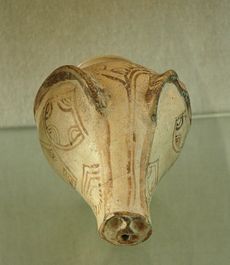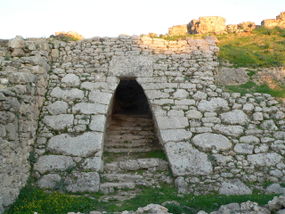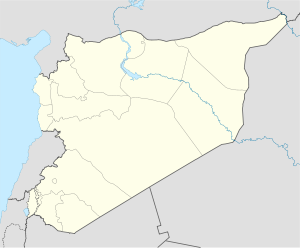Ugarit

Excavated ruins at Ras Shamra.
|
||||||||||||||||||||||||||||||||||||||
Ugarit (Ugaritic: 𐎜𐎂𐎗𐎚: ʼugrt; Arabic: أوغاريت; Hebrew: אוּגָרִית) (modern Ras Shamra رأس شمرة ("top/head/cape of the wild fennel" in Arabic), near Latakia, Syria) was an ancient cosmopolitan port city, sited on the Mediterranean coast. Ugarit sent tribute to Egypt and maintained trade and diplomatic connections with Cyprus (called Alashiya), documented in the archives recovered from the site and corroborated by Mycenaean and Cypriot pottery found there. The polity was at its height from ca. 1450 BC until 1200 BC.
Contents |
Location
Ras Shamra (“Fennel Head”) is a sixty-five foot mound located near Minet el-Beida (White Harbor) in northern Syria. It is some seven miles north of Laodicea ad Mare and approximately fifty miles east of the point of Cyprus. Ras Shamra, as it is known today, was identified as the ancient city of Ugarit.
The site
Ugarit's location was forgotten until 1928 when a peasant accidentally opened an old tomb while ploughing a field. The discovered area was the Necropolis of Ugarit located in the nearby seaport of Minet el-Beida. Excavations have since revealed an important city that takes its place alongside Ur and Eridu as a cradle of urban culture, with a prehistory reaching back to ca. 6000 BC, perhaps because it was both a port and at the entrance of the inland trade route to the Euphrates and Tigris lands.

Most excavations of Ugarit were undertaken by archaeologist Claude Schaeffer from the Prehistoric and Gallo-Roman Museum in Strasbourg.
The excavations uncovered a royal palace of 90 rooms laid out around eight enclosed courtyards, many ambitious private dwellings, including two private libraries (one belonging to a diplomat named Rapanu) that contained diplomatic, legal, economic, administrative, scholastic, literary and religious texts. Crowning the hill where the city was built were two main temples: one to Baal the "king", son of El, and one to Dagon, the chthonic god of fertility and wheat.
On excavation of the site, several deposits of cuneiform clay tablets were found, constituting a palace library, a temple library and—apparently unique in the world at the time—two private libraries; all dating from the last phase of Ugarit, around 1200 BC. The tablets found at this cosmopolitan center are written in four languages: Sumerian, Hurrian, Akkadian (the language of diplomacy at this time in the ancient Near East), and Ugaritic (of which nothing had been known before). No less than seven different scripts were in use at Ugarit: Egyptian and Luwian hieroglyphs, and Cypro-Minoan, Sumerian, Akkadian, Hurrian, and Ugaritic cuneiform.
During excavations in 1958, yet another library of tablets was uncovered. These were, however, sold on the black market and not immediately recovered. The "Claremont Ras Shamra Tablets" are now housed at the Institute for Antiquity and Christianity, Claremont School of Theology, Claremont, California. They were edited by Loren R. Fisher in 1971. In 1973, an archive containing around 120 tablets was discovered during rescue excavations; in 1994 more than 300 further tablets were discovered on this site in a large ashlar building, covering the final years of the Bronze Age city's existence.
The most important piece of literature recovered from Ugarit is arguably the Baal cycle, describing the basis for the religion and cult of the Canaanite Baal.
History

Though the site is thought to have been inhabited earlier, Neolithic Ugarit was already important enough to be fortified with a wall early on, perhaps by 6000 BC.
The first written evidence mentioning the city comes from the nearby city of Ebla, ca. 1800 BC. Ugarit passed into the sphere of influence of Egypt, which deeply influenced its art. The earliest Ugaritic contact with Egypt (and the first exact dating of Ugaritic civilization) comes from a carnelian bead identified with the Middle Kingdom pharaoh Senusret I, 1971 BCE–1926 BC. A stela and a statuette from the Egyptian pharaohs Senusret III and Amenemhet III have also been found. However, it is unclear at what time these monuments got to Ugarit. Amarna letters from Ugarit ca. 1350 BC records one letter each from Ammittamru I, Niqmaddu II, and his queen.

From the 16th to the 13th century BC Ugarit remained in constant touch with Egypt and Cyprus (named Alashiya).
Destruction
The last Bronze Age king of Ugarit, Ammurapi, was a contemporary of the Hittite king Suppiluliuma II. The exact dates of his reign are unknown. However, a letter by the king is preserved. Ammurapi stresses the seriousness of the crisis faced by many Near Eastern states from invasion by the advancing Sea Peoples in a dramatic response to a plea for assistance from the king of Alasiya. Ammurapi highlights the desperate situation Ugarit faced in letter RS 18.147:
My father, behold, the enemy's ships came (here); my cities(?) were burned, and they did evil things in my country. Does not my father know that all my troops and chariots(?) are in the Land of Hatti, and all my ships are in the Land of Lukka?...Thus, the country is abandoned to itself. May my father know it: the seven ships of the enemy that came here inflicted much damage upon us.[1]
Unfortunately for Ugarit, no help arrived and Ugarit was burned to the ground at the end of the Bronze Age. Its destruction levels contained Late Helladic IIIB ware, but no LH IIIC (see Mycenaean period). Therefore, the date of the destruction is important for the dating of the LH IIIC phase. Since an Egyptian sword bearing the name of pharaoh Merneptah was found in the destruction levels, 1190 BC was taken as the date for the beginning of the LH IIIC. A cuneiform tablet found in 1986 shows that Ugarit was destroyed after the death of Merneptah. It is generally agreed that Ugarit had already been destroyed by the 8th year of Ramesses III—i. e. 1178 BC.
Whether Ugarit was destroyed before or after Hattusa, the Hittite capital, is debated. The destruction is followed by a settlement hiatus. Many other Mediterranean cultures were deeply disordered just at the same time, apparently by invasions of the mysterious "Sea Peoples".
Alphabet
Scribes in Ugarit appear to have originated the "Ugaritic alphabet" around 1400 BC; 30 letters, corresponding to sounds, were inscribed on clay tablets; although they are cuneiform in appearance, that is impressed in clay with the end of a stylus, they bear no relation to Mesopotamian cuneiform signs. A debate exists as to whether the Phoenician or Ugaritic "alphabet" was first. While the letters show little or no formal similarity, the standard letter order (preserved in the latin alphabet as A, B, C, D, etc.) shows strong similarities between the two, proving that the Phoenician and Ugaritic systems were not wholly independent inventions.
Ugaritic language
The Ugaritic language is attested in texts from the 14th through the 12th century BC. Ugaritic is usually classified as a Northwest Semitic language and therefore related to Hebrew, Aramaic, and Phoenician, among others. Its grammatical features are highly similar to those found in Classical Arabic and Akkadian. It possesses two genders (masculine and feminine), three cases for nouns and adjectives (nominative, accusative, and genitive); three numbers: (singular, dual, and plural); and verb aspects similar to those found in Western Semitic languages. The word order in Ugaritic is verb-subject-object (VSO); possessed–possessor (NG) (first element dependent on the function and second always in genitive case); and noun–adjective (NA) (both in the same case (i.e. congruent)).[2]
Ugaritic literature
Apart from royal correspondence to neighboring Bronze Age monarchs, Ugaritic literature from tablets found in the libraries include mythological texts written in a narrative poetry, letters, legal documents such as land transfers, a few international treaties, and a number of administrative lists. Fragments of several poetic works have been identified: the "Legend of Kirtu," the "Legend of Danel", the Ba'al tales that detail Baal-Hadad's conflicts with Yam and Mot, and other fragments.[3]
The discovery of the Ugaritic archives has been of great significance to biblical scholarship, as these archives for the first time provided a detailed description of Canaanite religious beliefs during the period directly preceding the Israelite settlement. These texts show significant parallels to Biblical Hebrew literature, particularly in the areas of divine imagery and poetic form. Ugaritic poetry has many elements later found in Hebrew poetry: parallelisms, meters, and rhythms. The discoveries at Ugarit have led to a new appraisal of the Old Testament as literature.
Ugaritic religion
The important textual finds from the Ras Shamra (Ugarit) site shed a great deal of light upon the cultic life of the city.[4] There is growing scholarly agreement that the material culture of Ugarit should be properly designated Canaanite High Culture.
In the north-east quarter of the walled enclosure the remains of three significant buildings were unearthed; the temples of Baal and Dagon and the library (sometimes referred to as the high priest's house). Within these structures atop the acropolis numerous invaluable mythological texts were found. Since the 1930s these texts have opened some initial understanding of the Canaanite mythological world. The Baal cycle represents Baal's destruction of Yam (the chaos sea monster), demonstrating the relationship of Canaanite chaoskampf with those of Mesopotamia and the Aegean: a warrior god rises up as the hero of the new pantheon to defeat chaos and bring order.
It is almost certain that the cult(s) of Baal in the Levant influenced later Israelite cult and mythology. Yahweh often takes on the chaoskampf role of Baal in his struggle with the chaotic sea. It would, however, be incorrect to use later redacted biblical texts to reconstruct Canaanite religion or cult.
While El is the chief of the Canaanite pantheon, very little attention is paid to him in the cultic/mythological texts. This is rather common of Middle to Late Bronze Age mythology; the high god is drawn into the background whilst new warrior deities move to centre stage. In Ugarit and much of the Levant this figure is Baal; to the Shasu / Shosu this is Yahweh and his consort, and in Mesopotamia this is Marduk. These warrior-god mythologies show remarkable points of contact and are most likely reflections of the same archetypal myth.
Kings of Ugarit
(short chronology)
| Ruler | Reigned | Comments |
|---|---|---|
| Ammittamru I | ca. 1350 BC | |
| Niqmaddu II | ca. 1350–1315 BC | Contemporary of Suppiluliuma I of the Hittites |
| Arhalba | ca. 1315–1313 BC | |
| Niqmepa | ca. 1313–1260 BC | Treaty with Mursili II of the Hittites, Son of Niqmadu II, |
| Ammittamru II | ca. 1260–1235 BC | Contemporary of Bentisina of Amurru, Son of Niqmepa |
| Ibiranu | ca. 1235–1225/20 BC | |
| Niqmaddu III | ca. 1225/20 – 1215 BC | |
| Ammurapi | ca. 1200 BC | Contemporary of Chancellor Bay of Egypt, Ugarit is destroyed |
See also
- Ugaritic language
- Ugaritic alphabet
- Ebla
- Elohim (gods)
- Ugaritic religious documents
- Short chronology timeline
References
- ↑ Jean Nougaryol et al. (1968) Ugaritica V: 87-90 no.24
- ↑ Stanislav Segert, A basic Grammar of the Ugaritic Language: with selected texts and glossary (1984) 1997.
- ↑ Nick Wyatt. Religious texts from Ugarit, (1998) rev. ed 2002.
- ↑ Gregorio Del Olmo Lete, Canaanite Religion: According to the Liturgical Texts of Ugarit, 2004.
Sources
- Bourdreuil, P. 1991. "Une bibliothèque au sud de la ville : Les textes de la 34e campagne (1973)". in Ras Shamra-Ougarit, 7 (Paris).
- Drews, Robert. 1995. The End of the Bronze Age: Changes in Warfare and the Catastrophe ca. 1200 BC (Princeton University Press). ISBN 0-691-02591-6
- Meletinskii, E. M., 2000 The Poetics of Myth
- Smith, Mark S., 2001. Untold Stories ; The Bible and Ugaritic Studies in the Twentieth Century ISBN 1-56563-575-2 Chapter 1: "Beginnings: 1928–1945"
- Ugarit Forschungen (Neukirchen-Vluyn). UF-11 (1979) honors Claude Schaeffer, with about 100 articles in 900 pages. pp 95, ff, "Comparative Graphemic Analysis of Old Babylonian and Western Akkadian", ( i.e. Ugarit and Amarna (letters), 3 others, Mari, OB,Royal, OB,non-Royal letters). See above, in text.
- Virolleaud, Charles, 1929. "Les Inscriptions cunéiformes de Ras Shamra." in Syria 10, pp 304–310.
- Yon, Marguerite, 2005. The City of Ugarit at Tell Ras Shamra ISBN 1-57506-029-9 (Translation of La cité d'Ugarit sur le Tell de Ras Shamra 1979)
- Ed. K. L. Younger Jr. "Ugarit at Seventy-Five," Eisenbrauns, 2007.
- William M. Schniedewind, Joel H. Hunt, 2007. A primer on Ugaritic: language, culture, and literature ISBN 0-521-87933-7 p. 14.
External links
- Abufares, 2010 - Echos from Ugarit [1]
- Ugrarit (Tell Shamra), Suggestion to have Ugrarit (Tell Shamra) recognized as a UNESCO world heritage site, in 1999.
- The Edinburgh Ras Shamra project includes an introduction to the discovery of Ugarit.
- Ugarit and the Bible
- Ugaritic Literature as an Aid to Understanding the Hebrew Bible (Old Testament)
- About the discovery of Ugarit
- Ugaritic culture, cult and art briefly outlined.
- Introduction to Ras Shamra (Ugarit), and a virtual museum of Ugaritic art.
- Resources on Biblical Archaeology
- Canaanite/Ugaritic Mythology
- Ugarit and Biblical Heritage - A site with descriptions of the primary and minor gods and generous excerpts from the actual stories.
- Brief history of Ugarit.
- Ugaritic texts and their relationship to the Old Testament.
- Le Royaume d'Ougarit (in French)
- Pictures of present day Ugarit

